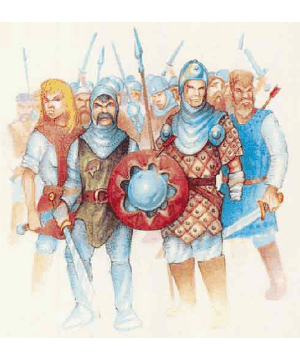

2501

| Climate/Terrain: | Any battle site |
|---|---|
| Frequency: | ery rare |
| Organization: | Troop |
| Activity Cycle: | Any |
| Diet: | Nil |
| Intelligence: | Not ratable (0) |
| Treasure: | Nil |
| Alignment: | Not applicable |
| No. Appearing: | Special |
| Armor Class: | 4 |
| Movement: | 12 |
| Hit Dice: | 3 |
| THAC0: | 17 |
| No. of Attacks: | 1 |
| Damage/Attack: | 1d8 (sword) |
| Special Attacks: | Fear |
| Special Defenses: | Nil |
| Magic Resistance: | Nil |
| Size: | M (6� tall) |
| Morale: | Fearless (20) |
| XP Value: | 120 |
A ghostly horde consists of the psychological remnants of an army that met a sudden or catastrophtc defeat. The horde is created by the losers� overwhelming desire to complete their task, whatever that may have been.
For those whose fear allows them to see it, the ghostly horse takes the form of the soldiers who lost the battle. No matter how long ago or how recently the battle took place, the soldiers appear exactly as they did on the day of their violent deaths; they make no sound whatsoever. Although such armies normally appear as they did in life, occasionally reports surface regarding ghostly hordes whose soldiers bear the seemingly still-fresh wounds that caused their deaths.
Combat: Since the members of a ghostly horde have no true consciousness or intelligence, it is the minds of their victims that give the horde its substance and power. Each character who enters a battlefield where a ghostly horde exists sees the spectral army appear at the edge of the battlefield and must roll a saving throw vs wands. If the saving throw succeeds, the horde fades away before mounting its attack. If the saving throw fails, the character sees the horde prepare to charge and must roll a second saving throw. A second failed saving throw indicates that the character has succumbed to fear, and the horde attacks.
Although the horde may number hundreds or thousands to the one who failed the saving throws, only one ghostly soldier actually attacks this panicked character. A victim struck by the soldier suffers 2d8 pomts of damage from its weapon and must roll a saving throw vs. death. Success means the character sustains normal damage; failure means the character falls unconsciuous, �slain� by the ghostly soldier. A �slain� character revives in 1d4 turns to find that only half the damage the soldier inflicted is real. The remaining damage does not appear in the form of cuts (as a real sword would inflict), but rather as a seriees of raised welts on the character�s body.
A character attacks a ghostly wamor as if it were a real opponent, causing normal damage. Note that each member of the ghostly horde has the equivalent of 3 Hit Dice. A character who �slays� a ghostly soldier in battle will not see the horde again on that battlefield and cannot be affected by them in any way.
Habitat/Society: The ghostly horde can exist only on deserted battlefields or in the city or town in which the army met its defeat, usually by magic. The horde has either infantry or cavalry soldiers, exactly as they looked when the living army first entered the field of battle. Some theorize that ghosty hordes can form only when the soldiers of the losing army all felt particularly dedicated to the cause for which they gave their lives � their spirits yet struggle to complete their task and vanquish their long-departed foe. Sages suggest that the apparitions within a ghostly horde can go to their rest only if the cause for which they once fought finally succeeds.
It is interesting to note that every person who enters a ghosty horde�s field of battle may well see something different. Some see nothing, feeling nothing more than a general unease, while their closest companion may see himself in mortal combat with a member of the ghostly company. The wild, slashing sword welts and the sudden, stumbling faint as the character is �slain� often seem extremely confusing to companions who have not seen the horde for themselves.
Ecology: The battlefields, deserted towns, and empty cities that house the spirits of a ghostly horde often remain surprisingly devoid of insects and small animal life. This phenomenon is particularly noticeable at dawn and dusk in the summer months: Across the entire battlefield, not a single cricket calls out to another.
Scholars and adventurers interested in discovering the secrets of lost civilisations sometimes search out the battlefields housing ghostly hordes. Often, a period of diligent digging and searching reveals ancient armor, weapons, treasure maps, and other items of interest. (After searching 1d4 days, characters have a 50% chance of success.) The value of such items varies widely with the particular horde and the interests of the searchers.
Last Modified: April 22, 2009, 13:50:24 GMT

◆ 787 ◆